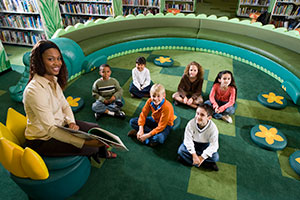 In recent years, it seems almost every learning center director or teacher who has invited me to do an author visit has asked the same question—can you help inspire our students to read and write about science?
In recent years, it seems almost every learning center director or teacher who has invited me to do an author visit has asked the same question—can you help inspire our students to read and write about science?
Perhaps it’s the recent push to incorporate more nonfiction texts (particularly with STEM/NextGen content) in the classroom, or the fact that many of my books are about science topics. Maybe it’s because I have an engineering degree and worked on rockets and car brakes before becoming an author. Whatever the reason, I’m happy when schools ask me to discuss science because I love sharing my geeky passion with students and performing my popular “trained ketchup packet” experiment.
Although my presentations create science enthusiasm on the day of my visit, or maybe even that entire week, I wanted to provide teachers with an engaging project that would inspire students to continue pursuing science after I head home. I asked a group of teachers what science subjects seem to interest their students most, and a clear winner quickly surfaced—inventions and inventors. Then I researched the benefits of independent, student-driven projects (the smashing idea behind Genius Hour) and discussed project ideas with teachers and students. In the end, I came up with the "Inventor’s Project."
What I like about this assignment is that students select their own subject (an inventor or invention) and the method they want to use to share their project: a written assignment, a drawing/design project with a brief narrative, or a hands-on building project with brief narrative.
A few teachers have given the Inventor Project a test run and kindly shared some helpful feedback. Several educators reported the last two options—drawing/design and hands-on building—were popular with their visual and kinesthetic learners. Schools with their own Makerspaces (also called FabLabs) were particularly enthused about the “building” option. Without further ado, I present the Inventor’s Project.
1. Invite students to research various inventors using books, reliable Internet sources, or both (see following list below), or provide the class with a curated collection of level-appropriate books on different inventors or a list of inventors from which they should choose.
2. Ask students to select an inventor they admire, want to learn more about, or both.
3. Invite students to select their own "Inventor Project" from the following options:
- Write a nonfiction narrative that shares the childhood experiences, struggles, and accomplishments of your inventor. The accomplishments will, of course, include inventions.
- Write a nonfiction narrative which shares one invention your inventor created, including why he or she decided to make it, what the invention does, and if or how it has changed the world.
- Imagine you are the inventor you’ve selected. Think about a new invention you would like to create and make a drawing of your invention. Put the invention’s name at the top of your drawing and label the main parts of your invention. In the lower right corner of the drawing, include a paragraph that describes what your invention does.
- Imagine you are the inventor you’ve selected. Build a simple invention that you have designed (something that doesn’t already exist) from materials you find in your home, garage, basement, or outside in nature. (Note: The invention you build may be a model of a larger invention that would actually work.) Write a paragraph which includes the name of your invention, what your invention does, and why you decided to create it.
Students could be invited to display their projects on a bulletin board or table or share their projects with the class through short oral presentations (2 or 3 minutes each). Share a few presentations each day of one week to create an "Inventor Week" celebration.
Internet Inventor Lists
 Suzanne Slade is the award-winning author of more than 100 children’s books. Her latest picture book, The Inventor’s Secret, shares the fascinating journeys of two famous inventors, Thomas Edison and Henry Ford, and has been called “the perfect title to kick off a Genius Hour program.” The book’s Activity Guide includes student science projects and fun science games. You can find more teacher resources on her webpage. Ms. Slade would love to receive your feedback or suggestions on the Inventor Project. Or, even better, send photos of your students’ projects and she’ll share them on her website!
Suzanne Slade is the award-winning author of more than 100 children’s books. Her latest picture book, The Inventor’s Secret, shares the fascinating journeys of two famous inventors, Thomas Edison and Henry Ford, and has been called “the perfect title to kick off a Genius Hour program.” The book’s Activity Guide includes student science projects and fun science games. You can find more teacher resources on her webpage. Ms. Slade would love to receive your feedback or suggestions on the Inventor Project. Or, even better, send photos of your students’ projects and she’ll share them on her website!